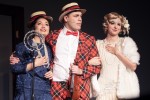Yellow raincoats, high-pitched voices and “talkies” will usher in HOOLIGAN Theatre Company’s fall season.
The company will perform a stage adaptation of the 1952 film “Singin’ in the Rain” at the Ralph Freud Playhouse starting Friday. The film chronicles the transition of silent-film costars Don Lockwood and Lina Lamont to talking films. Don struggles with the need to cross over to speaking films to further his career while Lina attempts to maintain stardom despite her unbearable voice. Director Jakob Garberg, a third-year English student, said even though the adaptation features the same plot and music as the film, some aspects, including personal performances and modernized dances, were adapted for the stage.
“(The show is) centered around Don’s change. We’re celebrating classic 1920’s Hollywood,” Garberg said. “A lot of the set pieces, … they’re meant to look fake. It’s showing this world isn’t entirely genuine – it’s very artificial. But through the acting you see these real human people come out. Even in this fake artificial world, there’s still room for humanity and genuine human nature.”
To emphasize the character development, actors’ let their personalities seep into the characters. Hila Oz, the third-year integrated theater studies student who portrays Lina, said she has never seen the movie or past Broadway productions, so she often draws from her own personality to act out the character. To express Lina’s anger at her studio boss in one scene, Oz said she draws from her own characteristics, such feelings of anxiety and franticness.
“It’s really exciting and kind of nerve-wracking and anxiety-inducing to play a really well-known and beloved character without having any knowledge of how she’s been played in the past,” Oz said. “In that way, I’ve made Lina completely my own. She is really my Lina.”
The musical numbers also allowed each actor’s individual personality to come through, said Danielle Jensen, a fourth-year theater student and choreographer of the production. All actors had to learn tap dance, but Jensen individually developed certain dance styles for each lead actor based off what they were comfortable doing and what their best style of dance was, she said. At the beginning of the production process, she said actors experimented to find their own comedic style and craft their character.
For instance, when working with the actor who plays Cosmo Brown, a friend of Don, Jensen choreographed his movements to intentionally accentuate and coincide with musical beats to create a more comedic personality, she said. In the number “Good Morning,” in which characters from the film dance at 2 a.m. after resolving a conflict at their film set, actors express their ideas of funny facial expressions or sounds to go along with the music as it shifts to convey a Hawaiian environment or the arrival of a Spanish conquistador, Jensen said.
Choreography for some of the musical numbers, such as “Good Morning” and “Singin’ in the Rain,” is true to the film, Jensen said. For example, in the musical number “Singin’ in the Rain,” Don jumps into puddles. To give the illusion of the wet weather in the film, Garberg said a combination of blue lights and rain-drop textures will accompany the actors’ dance movements.
However, some aspects of the original film will be altered for the stage, Jensen said. Certain musical numbers will blend both modern and classical dance styles, such as in “Broadway Melody.” The choreography includes ballroom-style partnering and a tap section.
To appeal to modern audiences, the choreography constantly shifts focus. Actors are tossed back-and-forth in the background while various groups pass through the stage and depart, unlike in the film, which primarily showcases Don’s movements, she said. In fact, the musical numbers provide a lighthearted element to the show, despite the plot’s focus on the characters’ struggle to transition to talking films, Jensen said.
“Everything back then used to be cleaner-cut, very prim and proper,” Jensen said. “We let this one go a little bit just to be more fun and spontaneous and sporadic.”
